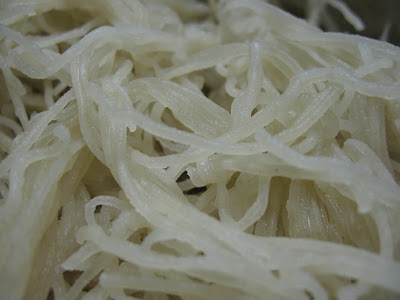Health-0-meter: 2/5 (5 being healthiest)
Ease: 1/5 (5 being difficult)
Sheera is my favorite Indian dessert of all time. It's served at religious rites (pujas) as well. The ingredients change depending on the rite (e.g chopped bananas). I always thought it was this intensely caloric comfort food, which it can be, but I did the nutritional analysis on my version and it wasn't too bad! Yay! More for me... :)
Ingredients:
Sooji/Rava - 1 cup
Ghee/butter - 1 tbsp
Sugar - 1/2 cup
Cardamom pods - 3*
Milk - 1 cup
Raisins - 1/4 cup
Almonds - 10 or 12, sliced or chopped into pieces
Cashews - 10 or 12, sliced or chopped into pieces
Almonds and cashews can be added in whatever quantity you like. I'm not a big fan of either in the raw form, but hubby loves them so I added the quantity called for in the recipe. If I was making it for myself, I would probably just put a couple of almonds.
*A note on cardamoms: They seeds you want are in the pods (see pics below). Use a rolling pin and crush the pods so that they open. Once open, take out the seeds within and discard the husks. Use the rolling pin to crush the seeds into a fine powder. Doesn't take more than a couple of minutes. Another option - you can leave the seeds as is, but I don't like it whole, so I tend to add the powdered version.

Raw sooji available in any Indian grocery store. This is the fine version, best used in sheera.

Cashews, almonds and cardamoms.

This little guy was naturally opened, giving us a peek into his heart. That's what the seeds look like.
Method:
1. Toast the nuts in a frying pan. No oil is needed. Keep stirring the nuts for 1 -2 minutes. You shouldn't have them turn a golden brown - that means they're too well done. It doesn't look very different from the raw form, but the taste between raw and toasted makes a world of a difference!

Toasted almonds and cashews (sorry for the blurry pic).
2. Add the tbsp of ghee or butter to the pan. As soon as it is done melting, add the sooji. Stir so that the ghee is completely mixed with the sooji. It will have the appearance of wet sand. Keep stirring for 4-5 minutes until it is toasted, at which point it will smell slightly nutty. Can't describe it, but you will get a faint [delicious] aroma. Toasting is very important! If the sooji isn't toasted, it could result in soggy sheera (blech).
While the sooji is toasting, bring the cup of milk to a low boil in a pot on another burner. It should not bubble, but it should be warm.
 Toasty, toasty
Toasty, toasty.
4. Add the cardamom powder or the whole seeds to the toasted sooji and stir until fully incorporated. The recipe I used added raisins to the sooji. I like raisins to be plump and juicy in the sheera so I added them to the milk while it was heating.
 Almost there!
Almost there!5. Add the milk to the pan containing the sooji. It will sputter at first, but will calm down in a minute. Mix thoroughly and stir in the sugar at this point. If the sugar is added before the milk, then it might caramelize due to the heat of the pan. Keep stirring until the mixture looks like raw cookie dough. Then take it off the burner and let it sit.

All done!

One serving of sheera right into my gaping maw. Yum!
And you're done! The whole process took me 20 minutes, so it's definitely easy to make and delicious to eat.
On to the nutritional analysis. The original recipe called for 3 tbsp of ghee and 3/4 cup of sugar. I cut the sugar to 1/2 cup and the ghee to 1 tbsp. I'm glad I did because it came out to the exact consistency that I love. :) I'm also the only Indian I know of who doesn't like her desserts on the sweet side. I'd like to take this opportunity to blame my mom as she brought my sis and me up with lo-everything - low fat, low sugar. I guess that's why I just couldn't accept the 3 tbsp even though I insist on following recipes to the letter when I make them for the first time. Hehehe... thanks Mom. :)
This recipe makes 2.75 cups of sheera. A serving size was designated as 1/2 cup.
Raisins, 1/4 cup (130)
Skim Milk, 1 cup (90)
Sugar, 1/2 cup (360)
Ghee, 1 tbsp (123)
Sooji, 1 cup (330)
Almonds & Cashews (170)
Cardamoms, 3 crushed (6)
Total calories: 1215
Calories per serving: 220 (see, not bad huh?)
'Til the next dish...



































 2. Heat oil in wok/frying pan. Add garlic and ginger and stir rapidly for 20 - 30 seconds. They should NOT turn brown, that means the garlic is burnt and it will impart a bitter taste to the curry.
2. Heat oil in wok/frying pan. Add garlic and ginger and stir rapidly for 20 - 30 seconds. They should NOT turn brown, that means the garlic is burnt and it will impart a bitter taste to the curry. 






